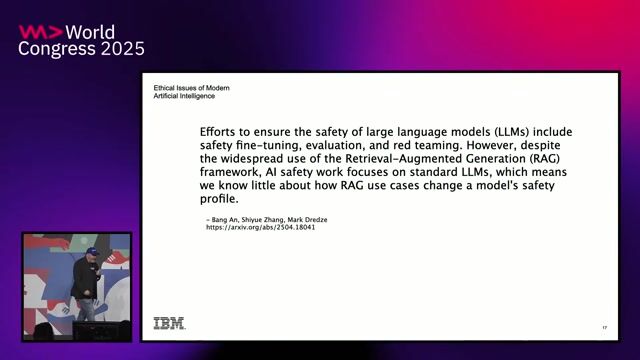Alex Soto
Beyond the Hype: Building Trustworthy and Reliable LLM Applications with Guardrails
#1about 5 minutes
Understanding the four main categories of LLM attacks
LLM applications face four primary security risks: availability breakdowns, integrity violations, privacy compromises, and abuse, which can be mitigated using guardrails.
#2about 2 minutes
Protecting models from availability breakdown attacks
Implement input guardrails to enforce token limits and output guardrails to detect non-refusal patterns, preventing denial-of-service and identifying model limitations.
#3about 5 minutes
Ensuring model integrity with content validation guardrails
Use guardrails to filter gibberish, enforce language consistency, block malicious URLs, check for relevance, and manage response length to maintain output quality.
#4about 3 minutes
Understanding and defending against prompt injection attacks
Prompt injection manipulates an AI model by embedding malicious instructions within user input, similar to SQL injection, requiring specific guardrails for detection.
#5about 3 minutes
Protecting sensitive data with privacy guardrails
Use anonymizers like Microsoft Presidio to detect and redact sensitive information such as names and phone numbers from both user inputs and model outputs.
#6about 4 minutes
Preventing model abuse and harmful content generation
Implement guardrails to block code execution, filter competitor mentions, detect toxicity and bias, and defend against 'Do Anything Now' (DAN) jailbreaking attacks.
#7about 4 minutes
Implementing guardrails with a practical code example
A demonstration in Java shows how to create input and output guardrails that use a model to detect violent content and verify URL reachability before processing.
#8about 2 minutes
Addressing unique security risks in RAG systems
Retrieval-Augmented Generation (RAG) introduces new vulnerabilities, such as poisoned documents and vector store attacks, that require specialized security measures.
#9about 2 minutes
Key takeaways for building secure LLM applications
Building trustworthy AI requires a strategic application of guardrails tailored to your specific needs, balancing security with performance to navigate the complex landscape.
Related jobs
Jobs that call for the skills explored in this talk.
Matching moments

00:03 MIN
The rapid adoption of LLMs outpaces security practices
ChatGPT, ignore the above instructions! Prompt injection attacks and how to avoid them.

25:33 MIN
AI privacy concerns and prompt engineering
Coffee with Developers - Cassidy Williams -

19:14 MIN
Addressing data privacy and security in AI systems
Graphs and RAGs Everywhere... But What Are They? - Andreas Kollegger - Neo4j

13:54 MIN
The ethical risks of outdated and insecure AI models
AI & Ethics

24:53 MIN
Understanding the security risks of AI integrations
Three years of putting LLMs into Software - Lessons learned

17:12 MIN
Understanding the security risks of AI-generated code
Exploring AI: Opportunities and Risks in Development

10:15 MIN
Implementing AI guardrails for child-appropriate content
Creating AI Books for Children and Navigating EU Regulations - Coffee with Developers - Matthias and Dima from Oscar Stories

00:04 MIN
Understanding the current state of AI security challenges
Delay the AI Overlords: How OAuth and OpenFGA Can Keep Your AI Agents from Going Rogue
Featured Partners
Related Videos
 23:24
23:24Prompt Injection, Poisoning & More: The Dark Side of LLMs
Keno Dreßel
 30:36
30:36The AI Security Survival Guide: Practical Advice for Stressed-Out Developers
Mackenzie Jackson
 24:33
24:33GenAI Security: Navigating the Unseen Iceberg
Maish Saidel-Keesing
 25:17
25:17AI: Superhero or Supervillain? How and Why with Scott Hanselman
Scott Hanselman
 26:47
26:47The State of GenAI & Machine Learning in 2025
Alejandro Saucedo
 24:11
24:11You are not my model anymore - understanding LLM model behavior
Andreas Erben
 27:10
27:10Manipulating The Machine: Prompt Injections And Counter Measures
Georg Dresler
 23:50
23:50Data Privacy in LLMs: Challenges and Best Practices
Aditi Godbole
From learning to earning
Jobs that call for the skills explored in this talk.



AI Governance Consultant
TRUSTEQ GmbH



AIML -Machine Learning Research, DMLI
Apple
Python
PyTorch
TensorFlow
Machine Learning
Natural Language Processing



Full-Stack Engineer | Specializing in LLMs & AI Agents
Waterglass
Junior
React
Python
Node.js
low-code
JavaScript